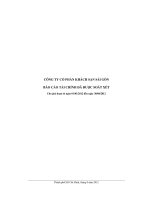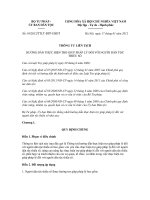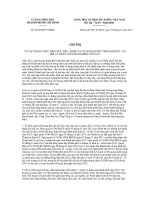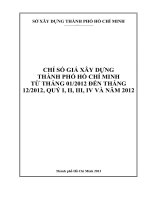Astm f 901 01 (2012)
Bạn đang xem bản rút gọn của tài liệu. Xem và tải ngay bản đầy đủ của tài liệu tại đây (96.38 KB, 4 trang )
Designation: F901 − 01 (Reapproved 2012)
Standard Specification for
Aluminum Transmission Tower Bolts and Nuts1
This standard is issued under the fixed designation F901; the number immediately following the designation indicates the year of original
adoption or, in the case of revision, the year of last revision. A number in parentheses indicates the year of last reapproval. A superscript
epsilon (´) indicates an editorial change since the last revision or reapproval.
F1470 Practice for Fastener Sampling for Specified Mechanical Properties and Performance Inspection
2.2 ASME Standards:4
B1.1 Unified Inch Screw Threads (UN and UNR Thread
Form)
B18.2.1 Square and Hex Bolts and Screws (Inch Series)
Addenda A
B18.2.2 Square and Hex Nuts
2.3 Military Standard:
MIL-STD-A-8625 Anodic Coatings for Aluminum and
Aluminum Alloys5
1. Scope
1.1 This specification covers aluminum structural bolts and
nuts for use in the construction of aluminum transmission
towers, substations, and similar aluminum structures.
1.2 Diameters of bolts and nuts furnished to this specification are 5⁄8, 3⁄4, and 7⁄8 in.
1.3 The values stated in inch-pound units are to be regarded
as standard. The values given in parentheses are mathematical
conversions to SI units that are provided for information only
and are not considered standard.
3. Ordering Information
2. Referenced Documents
3.1 Orders for bolts and nuts under this specification shall
include the following:
3.1.1 Quantity (number of pieces of each item and size);
3.1.2 Name of item;
3.1.3 Size (diameter, threads per inch, length);
3.1.4 Alloy number;
3.1.5 Shipment lot testing, as required (see Supplementary
Requirements S1);
3.1.6 Source inspection, if required (see Section 14);
3.1.7 Certificate of compliance or test report, if required
(see Section 16);
3.1.8 Additional requirements, if any, to be specified on the
purchase order (see 4.2.1, 4.2.3, 8.2.1, 8.2.2, 9.2, 12.1, and
13.1);
3.1.9 Supplementary requirements, if any; and
3.1.10 ASTM specification and year of issue.
2
2.1 ASTM Standards:
B565 Test Method for Shear Testing of Aluminum and
Aluminum-Alloy Rivets and Cold-Heading Wire and
Rods
D3951 Practice for Commercial Packaging
E29 Practice for Using Significant Digits in Test Data to
Determine Conformance with Specifications
E34 Test Methods for Chemical Analysis of Aluminum and
Aluminum-Base Alloys
E55 Practice for Sampling Wrought Nonferrous Metals and
Alloys for Determination of Chemical Composition
E101 Test Method for Spectrographic Analysis of Aluminum
and Aluminum Alloys by the Point-to-Plane Technique
(Withdrawn 1996)3
E227 Test Method for Optical Emission Spectrometric
Analysis of Aluminum and Aluminum Alloys by the
Point-to-Plane Technique (Withdrawn 2002)3
F606 Test Methods for Determining the Mechanical Properties of Externally and Internally Threaded Fasteners,
Washers, Direct Tension Indicators, and Rivets
NOTE 1—Example: 10 000 pieces Aluminum Transmission Tower Bolt,
0.750-10 by 2.00 in., Alloy 2024-T4, Furnish Certificate of Compliance,
Supplementary Requirement S2, ASTM F901–XX.
4. Materials and Manufacture
4.1 Materials—Bolts shall be manufactured from Alloy
2024 and nuts from Alloy 6061 or 6262. The materials
chemical composition shall be capable of developing the
mechanical properties required by Table 1, when in the finished
condition.
1
This specification is under the jurisdiction of ASTM Committee F16 on
Fasteners and is the direct responsibility of Subcommittee F16.04 on Nonferrous
Fasteners.
Current edition approved April 1, 2012. Published May 2012. Originally
approved in 1984. Last previous edition approved in 2007 as F901 – 01(2007). DOI:
10.1520/F0901-01R12.
2
For referenced ASTM standards, visit the ASTM website, www.astm.org, or
contact ASTM Customer Service at For Annual Book of ASTM
Standards volume information, refer to the standard’s Document Summary page on
the ASTM website.
3
The last approved version of this historical standard is referenced on
www.astm.org.
4
Available from IHS, 15 Inverness Way East, Englewood, CO 80112, http://
www.global.ihs.com.
5
Available from Standardization Documents Order Desk, DODSSP, Bldg. 4,
Section D, 700 Robbins Ave., Philadelphia, PA 19111-5098, http://
dodssp.daps.dla.mil.
Copyright © ASTM International, 100 Barr Harbor Drive, PO Box C700, West Conshohocken, PA 19428-2959. United States
1
F901 − 01 (2012)
TABLE 1 Tensile Strength of 2024-T4 Bolts and Proof Loads for
6061-T6 and 6262-T9 NutsA
Bolt Size, in.
Tensile Strength, min, lbf (kN)
⁄
3 ⁄4
7 ⁄8
12 400 (55)
18 400 (82)
25 400 (113)
58
TABLE 3 Sample Size and Acceptance for Mechanical Property
Tests
Acceptance Criteria
Number of Pieces in Lot
Number of
Tests
Acceptance
Number
Rejection
Number
2
3
5
8
0
0
0
0
1
1
1
1
50 and under
51 to 500
501 to 35 000
35 001 to 100 000
A
Based on a tensile unit stress of 55 000 psi (380 MPa) and the thread stress
area calculated as follows:
A s 5 0.7854 f D 2 s 0.9743/n d g 2
where:
As
D
n
= stress area,
= nominal diameter, and
= threads/in.
6. Mechanical Properties
6.1 Bolts—Bolts having a length three times the diameter or
longer shall be tested full size as specified in 13.2.2. At the
manufacturer’s option, bolts of less than 3 diameters in length
may be tested in full size as specified in 13.2.2. Bolts subjected
to tension tests shall meet the tensile strength requirements
specified in Table 1. Bolts of less than 3 diameters in length or
for other reasons cannot be tested full size in tension, shall be
subject to a shear test to be performed in accordance with
12.2.1. The test results shall conform to the following minimum shear-strength requirements: 37 ksi (255 MPa) for
2024-T4.
4.2 Manufacture:
4.2.1 Forming—Unless otherwise specified, the bolts and
nuts shall be cold formed, hot formed, or machined from
suitable material at the option of the manufacturer.
4.2.2 Condition—The fasteners shall be furnished in the
following conditions:
Alloy
Fastener
2024-T4
6061-T6
6262-T9
bolts
nuts
nuts
Condition
solution treated and naturally aged
solution treated and artificially aged
solution treated, artificially aged, and
cold worked
6.2 Nuts—Nuts shall be tested in accordance with the
mechanical requirements for the applicable type and shall meet
the minimum proof-load requirements in Table 1.
4.2.3 Threads—Unless otherwise specified, the threads shall
be rolled or cut at the option of the manufacturer.
7. Significance of Numerical Limits
7.1 For purposes of determining compliance with the specified limits for requirements of the properties listed in this
specification, an observed value or calculated value shall be
rounded in accordance with Practice E29.
5. Chemical Composition
5.1 Chemical Composition Limits—The bolts and nuts shall
conform to the requirements as to chemical composition
prescribed in Table 2.
8. Dimensions
5.2 Manufacturer’s Analysis—When test reports are required on the inquiry or purchase order (see 3.1.7), the
manufacturer shall furnish a certificate of conformance certifying compliance with the chemical limits specified in Table 2.
8.1 Bolts and Nuts:
8.1.1 Bolts—Bolts shall be full-size body in accordance
with the requirements of AMSE B18.2.1, except the full-body
length listed in Table 4 shall be the basis of manufacture and
inspection. Unless otherwise specified, hex bolts shall be
furnished. The ends of the bolts need not be chamfered or
pointed.
8.1.2 Nuts—The dimensions of the nuts shall be in accordance with the requirements of ASME B 18.2.2. Unless
otherwise specified, nuts are to be either the regular hex series
or a recessed hex series that allows penetration of the bolt
threads into the nut recess area.
5.3 Product Analysis:
5.3.1 Product analyses may be made by the purchaser from
finished products representing each lot. The chemical composition thus determined shall conform to the requirements in
Table 2.
5.3.2 In the event of disagreement, a referee chemical
analysis shall be performed if agreed upon by both parties. A
sample as required by Table 3 shall be selected for each lot.
Chemical analysis shall be performed to the requirements of
13.1 and the result shall conform to Table 2.
8.2 Threads:
TABLE 2 Chemical RequirementsA,B
UNS
Designation
Number
Alloy
A92024
A96061
A96262
2024
6061
6262
General Name AluminumC Chromium
Aluminum 2024
Aluminum 6061
Aluminum 6262
Balance
Balance
Balance
0.10
0.04–0.35
0.04–0.14
Other Elements
Copper
3.8–4.9
0.15–0.40
0.15–0.40
Iron
0.50
0.7
0.7
A
Manganese
0.30–0.9
0.15
0.15
Silicon
0.50
0.40–0.8
0.40–0.8
Titanium
0.15
0.15
0.15
Zinc
0.25
0.25
0.25
Magnesium
1.2–1.8
0.8–1.2
0.8–1.2
Each
Total
0.05
0.05
0.05D
0.15
0.15
0.15
Limits are in percent, maximum, unless shown as a range or stated otherwise.
Analysis shall regularly be made only for the elements specified in this table. If, however, the presence of other elements is suspected or indicated in amounts greater
than the specified limits, further analysis shall be made to determine that these elements are not present in excess of the specified limits.
C
Balance shall be arithmetically computed by deducting the sum of the other named elements from 100.
D
Lead 0.4–0.7 %; bismuth 0.4-0.7 %.
B
2
F901 − 01 (2012)
TABLE 4 Length of Full Body for BoltsA
11.2.2 If the failure of a test specimen is due to improper
preparation of the specimen or to incorrect testing technique,
the specimen shall be discarded and another specimen substituted.
Bolt Diameter, in.
Length of
Bolt, in.
Color Code
1
1 1 ⁄4
1 1 ⁄2
1 3 ⁄4
Red
Blue
Gold
Green
...
1⁄16
1 ⁄4
1 ⁄2
2
2 1 ⁄4
2 1 ⁄2
2 3 ⁄4
Red
Blue
Gold
Green
3
3 1 ⁄4
3 1 ⁄2
3 3 ⁄4
4
⁄
⁄
78
3 16
12
⁄
⁄
...
...
...
7⁄16
⁄
1
11⁄4
11⁄2
⁄
1
1 1⁄ 4
1 1⁄ 2
⁄
⁄
13⁄16
17⁄16
Red
Blue
Gold
Green
13 ⁄ 4
2
21⁄4
21⁄2
1 3⁄ 4
2
2 1⁄ 4
2 1⁄ 2
111⁄16
115⁄16
23⁄16
27⁄16
12.2 Mechanical Tests:
12.2.1 Bolts—Machined shear test specimens, when required, shall be taken in accordance with Test Method B565.
12.2.2 Nuts—Nuts shall be tested in full section.
Red
23 ⁄ 4
2 3⁄ 4
211⁄16
13. Test Methods
58
34
34
⁄
⁄
3 16
14
34
⁄
12. Specimen Preparation
12.1 Chemical Tests—When required, samples for chemical
analysis shall be taken in accordance with Practice E55 by
drilling, sawing, milling, turning, clipping, or other such
methods capable of producing representative samples.
11 16
15 16
A
The length of full body is the distance from the underside of the head to the first
scratch of thread on bolts with machine-cut threads, or top of the extrusion angle
for bolts with rolled threads with a tolerance of ± 1⁄32 in. for 5⁄8- and 3⁄4-in. size bolts,
and ± 1⁄16 in. for 7⁄8-in. size bolts.
13.1 Chemical Analysis—The chemical composition may be
determined by any recognized commercial test method. In the
event of disagreement, the following test methods shall be used
for referee purposes: E34, E101, or E227.
13.2 Mechanical:
13.2.1 Tests shall be conducted in accordance with Test
Methods B565 and F606.
13.2.2 Bolts that can be tested full size shall be tested using
the wedge tension test specified in Test Methods F606. Fracture
shall be in the body or threaded portion of the bolt without any
failure at the junction of the head and body.
13.2.3 When machined specimens for shear tests are necessary (see Section 6), determine the shear strength on each
sample in accordance with Test Method B565.
13.2.4 Nuts shall be proof-load or proof-stress tested as
specified in Test Methods F606.
8.2.1 Bolts—Unless otherwise specified, the bolts shall be
Class 2A threads in accordance with ASME B1.1.
8.2.2 Nuts—Unless otherwise specified, the nuts shall be
Class 2B threads in accordance with ASME B1.1.
9. Workmanship, Finish, and Appearance
9.1 Workmanship—Bolts and nuts shall have a workmanlike
finish free of injurious burrs, seams, laps, irregular surfaces,
and other imperfections affecting serviceability.
9.2 Finish:
9.2.1 Bolts—Unless otherwise specified, bolts shall be furnished anodized per MIL-STD-A-8625, Type II, Class 2 and
color coded for length as indicated in Table 4.
9.2.2 Nuts—Unless otherwise specified, nuts shall be furnished waxed.
14. Inspection
14.1 When specified on the inquiry or purchase order, the
product shall be subject to inspection by the purchaser at the
place of manufacture prior to shipment. The inspector representing the purchaser shall have controlled entry only to those
parts of the manufacturer’s operations that concern the manufacturer of the ordered product and only when and where work
on the contract of the purchaser is being performed. The
manufacturer shall afford the inspector all reasonable facilities
to satisfy that the product is being furnished in accordance with
this specification. All inspections and tests shall be conducted
so as not to interfere unnecessarily with the operations of the
manufacturer.
10. Sampling
10.1 A lot, for the purposes of selecting test specimens, shall
consist of no more than 100 000 pieces offered for inspection
at one time having the following common characteristics:
10.1.1 One type of item (that is, bolts or nuts),
10.1.2 Same alloy and temper,
10.1.3 One nominal diameter and thread series, and
10.1.4 One nominal length or thickness.
15. Rejection and Rehearing
11. Number of Tests and Retests
15.1 Unless otherwise specified, any rejection based on tests
specified herein and made by the purchaser shall be reported to
the manufacturer as soon as is practical after receipt of the
product by the purchaser.
11.1 Tests—The requirements of this specification shall be
met in continuous mass production for stock. The manufacturer
shall make sample inspections, as specified in Table 3, to
ensure that the product conforms to the specified requirements.
When tests of individual shipments are required, Supplementary Requirement S1 must be specified.
16. Certification and Test Reports
16.1 Certificate of Compliance—When specified in the contract or purchase order, the manufacturer shall furnish certification that the product was manufactured and tested in accordance with this specification and conforms to all specified
requirements.
11.2 Retests:
11.2.1 When tested in accordance with the required sampling plan, a lot shall be subject to rejection if any of the test
specimens fails to meet the applicable test requirement.
3
F901 − 01 (2012)
17.3.2 When special packaging requirements are required
by the purchaser, they shall be defined at the time of inquiry
and order.
16.2 Test Reports—When shipment lot testing in accordance
with Supplementary Requirement S1 is specified in the contract or purchase order, the manufacturer shall furnish a test
report showing the results of the mechanical tests for each lot
shipped.
17.4 Package Marking: Each shipping unit shall include or
be plainly marked with the following:
17.4.1 ASTM specification,
17.4.2 Alloy condition,
17.4.3 Alloy number,
17.4.4 Size,
17.4.5 Name and brand or trademark of the manufacturer,
17.4.6 Country of origin,
17.4.7 Number of pieces, and
17.4.8 Purchase order number.
17. Product Marking, Packaging, and Shipping
17.1 Bolt heads shall be marked to identify the manufacturer. The manufacturer may use additional markings for his
own use. Markings shall be raised or depressed, at the option
of the manufacturer. Nuts are not required to be marked.
17.2 Bolts and nuts shall be shipped assembled unless
otherwise specified.
17.3 Packaging:
17.3.1 Unless otherwise specified packaging shall be in
accordance with Practice D3951.
SUPPLEMENTARY REQUIREMENTS
One or more of the following supplementary requirements shall apply only when specified by the
purchaser in the inquiry, contact, or order. Supplementary requirements shall in no way negate any
requirement of the specification itself.
S1.3 The manufacturer shall perform mechanical property
tests in accordance with this specification and Guide F1470 on
the individual lots for shipment.
S1.4 The manfacturer shall furnish a test report for each lot
in the shipment showing the actual results of the chemical
analysis and mechanical property tests performed in accordance with Supplementary Requirement S1.
S1. Shipment Lot Testing
S1.1 When Supplementary Requirement S1 is specified on
the order, the manufacturer shall make sample tests on the
individual lots for shipment to ensure that the product comforms to the specified requirements.
S1.2 The manufacturer shall make an analysis of a randomly selected finished fastener from each lot of product to be
shipped. If heat or lot control has been maintained, the analysis
of the starting material from which the fasteners have been
manufactured may be reported in place of the product analysis.
S2. Product Marking
S2.1 Bolts shall be marked with their nominal length in
inches and fractions.
ASTM International takes no position respecting the validity of any patent rights asserted in connection with any item mentioned
in this standard. Users of this standard are expressly advised that determination of the validity of any such patent rights, and the risk
of infringement of such rights, are entirely their own responsibility.
This standard is subject to revision at any time by the responsible technical committee and must be reviewed every five years and
if not revised, either reapproved or withdrawn. Your comments are invited either for revision of this standard or for additional standards
and should be addressed to ASTM International Headquarters. Your comments will receive careful consideration at a meeting of the
responsible technical committee, which you may attend. If you feel that your comments have not received a fair hearing you should
make your views known to the ASTM Committee on Standards, at the address shown below.
This standard is copyrighted by ASTM International, 100 Barr Harbor Drive, PO Box C700, West Conshohocken, PA 19428-2959,
United States. Individual reprints (single or multiple copies) of this standard may be obtained by contacting ASTM at the above
address or at 610-832-9585 (phone), 610-832-9555 (fax), or (e-mail); or through the ASTM website
(www.astm.org). Permission rights to photocopy the standard may also be secured from the ASTM website (www.astm.org/
COPYRIGHT/).
4









